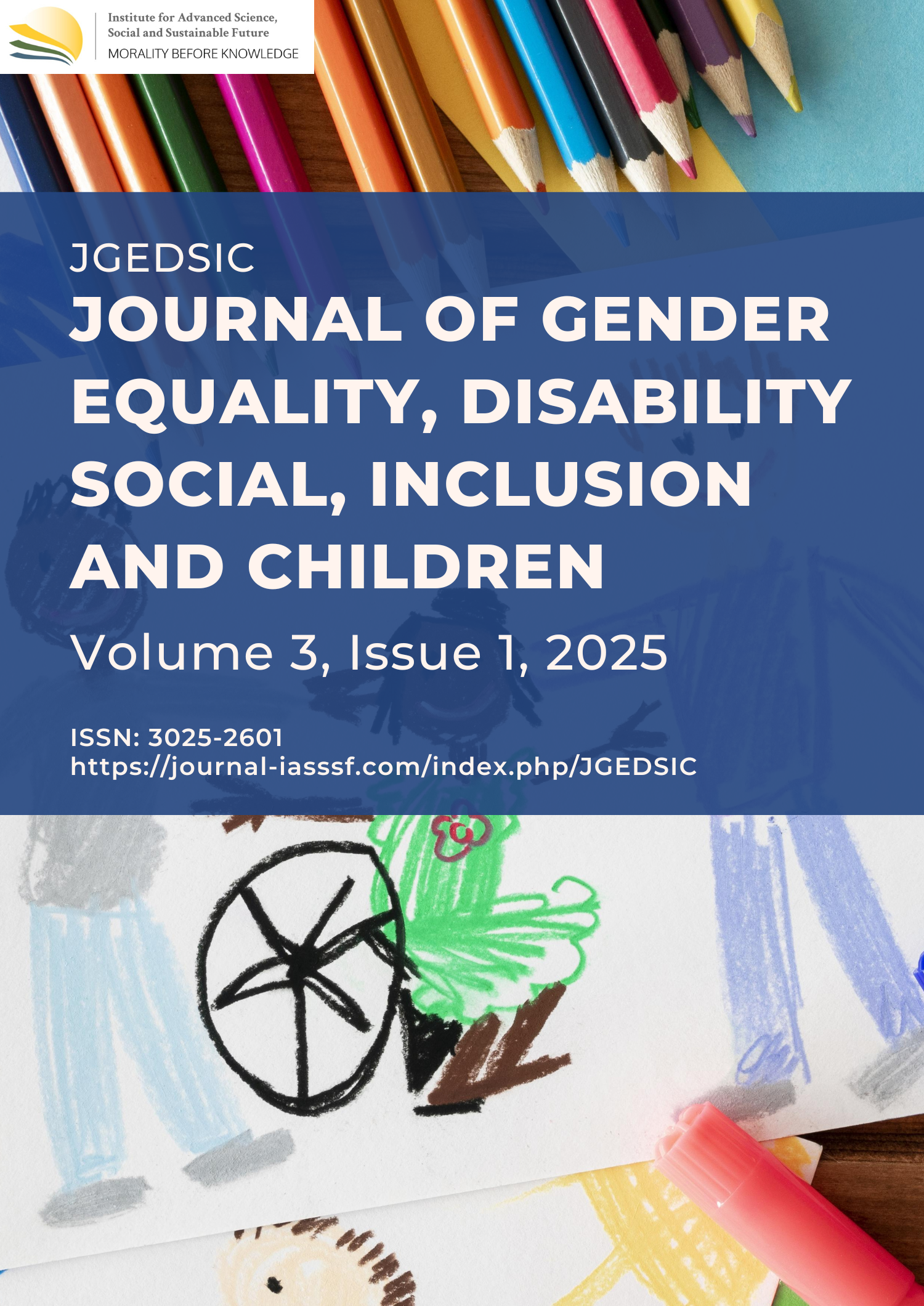Effective strategies and practical implementation in teaching english to deaf students: Insights from a qualitative case study of communication approaches and learning media
DOI:
https://doi.org/10.61511/jgedsic.v3i1.2025.1897Keywords:
deaf students, implementation of the strategies, teaching strategiesAbstract
Background: Deafness is a condition when a person cannot hear, either partially or completely. Deaf students have different ways of communicating with other people, including the way they learn things. Teachers need to use special methods in teaching deaf students so that the objectives of the teaching and learning process can be achieved. This research aims to identify the strategies used by teachers in teaching English to deaf students and find out how these strategies are implemented. Methods: This research uses a qualitative descriptive method and is based on a case study at SMPLB Karya Bakti Don Bosco Wonosobo (Special School for the Deaf). To find answers to these problems, this study interviewed an English teacher about the strategies implemented during the learning process in the classroom. To obtain more in-depth data, researchers also conducted classroom observations. Findings: This research shows that teachers use sign language strategies, read lips and use various media. As for the implementation of this strategy, the teacher focuses more on enriching students' vocabulary, the teacher speaks slowly and clearly when using sign language. teachers teach simple conversations; teachers use varied media. Conclusion: Teaching English to deaf students requires tailored strategies such as sign language, lip-reading, and media use, which must be implemented with patience and persistence to support effective learning. Novelty/Originality of this article: The findings in this study emphasize the fact that teaching deaf students requires excessive effort and great persistence, and the strategies presented in this study can be useful for other English teachers teaching deaf students.
References
Abidin, Z. (2021). Implementasi reward dan punishment terhadap peningkatan kosa kata bahasa Inggris di Bintana Research and Literacy Shelter Indonesia. Fenomena: Jurnal Pendidikan dan Pembelajaran, 20(2). https://doi.org/10.35719/fenomena.v20i2.62
Arikunto, S. (2002). Metodologi penelitian: Suatu pendekatan proposal. PT. Rineka Cipta.
Ary, D. (2010). Introduction to research in education. Wadsworth.
Bishaw, B. (2012). Teaching English to the students with difficulties in inclusive. International Journal of Physical and Social Sciences, 2(11), 93–107.
Creswell, J. W. (2009). Research design: Qualitative, quantitative, and mixed methods approaches. SAGE Publications.
Douglas, B. (2000). Principles of English learning and teaching (4th ed.). State University.
Fatimah, N. H. (2019). Teacher’s strategies in teaching English for the hearing-impaired students. English Education Journal, 7(2). https://doi.org/10.20961/eed.v7i2.35818
Greenberg, C. A., & Garfield, T. S. (1983). Nonverbal intelligence and verbal achievement in deaf adolescents: An examination of heredity and environment. American Annals of the Deaf, 128, 458–466. https://doi.org/10.1353/aad.2012.1028
Hamzah, B. U. (2016). Model pembelajaran menciptakan proses belajar mengajar yang kreatif dan efektif. Bumi Aksara.
Hastuti, E. D. (2009). Meningkatkan kemampuan percakapan bahasa inggris dengan model make a match pada siswa tunarungu wicara dan tunagrahita kelas VII SMPLB. Jurnal Asesmen Dan Intervensi Anak Berkebutuhan Khusus, 10(1), 66-75. https://doi.org/10.17509/jassi.v10i1
Hornby, A. S. (1995). Advanced learner’s dictionary. Oxford University Press. https://lib.ui.ac.id/detail.jsp?id=100665
Kodiango, W. O., & Syomwene, A. (2016). Challenges faced by the hearing impaired learners in composition writing and in answeringcomprehension questions in english language lessons. European Journal of Education Studies. http://dx.doi.org/10.46827/ejes.v0i0.327
Marschark, M., Marc, M., & Patricia, E. S. (2003). Deaf studies, language, and education. Oxford University Press.
Miles, M. B., & Huberman, A. M. (1984). Qualitative data analysis: A sourcebook of new methods. Sage Publications.
Miles, M., Mathew, B., & Huberman, M. (1994). An expanded sourcebook: Qualitative data analysis. Sage Publications.
Moleong, L. J. (2007). Metodologi penelitian kualitatif. Remaja Rosdakarya.
Ngalimun, N. (2016). Strategi dan model pembelajaran. Aswaja Pressindo.
Omondi, W. (2016). Challenges faced by the hearing impaired learners in composition writing and in answering comprehension questions during English language lessons. European Journal of Education Studies, 2(1), 1–10. https://doi.org/10.5281/zenodo.1134658
Patricia, P. (2010). Using a sign language in the teaching of English to deaf pupils. Bergen.
Patricia, P. (2015). The teaching of English to deaf pupils in Norway. Statped Vest.
Pratama, A. (2016). The implementation of teaching and learning English for students with hearing impairment. English Education: Jurnal Pendidikan Bahasa Inggris Universitas Sebelas Maret, 5(2), 92–104.
Ristiani, A. (2018). Challenges in teaching English for the deaf students. ELLITE: Journal of English Language, Literature, and Teaching, 3(1), 16-20. https://doi.org/10.32528/ellite.v3i1.1773
Rofiandaru, M. (2013). Sistem pembelajaran bahasa isyarat (SIBI) menggunakan metode komunikasi total untuk penyandang tunarungu di SLBN Semarang. Jurnal Teknologi Informasi dan Ilmu Komputer (JTIIK), 9(4), 819–828. https://doi.org/10.25126/jtiik.201394.12344
Shields, M., & Lennox, M. (2017). Strategies to address educational needs of students who are deaf or hard of hearing. TEACH Journal of Christian Education, 11(2), 4-8. https://doi.org/10.55254/1835-1492.1357
Siregar, N. (2022). Peran pendidik/guru dan peserta didik dalam proses kegiatan belajar mengajar bahasa Inggris di SMP Plus Yayasan Sirajussa’adah Limo Depok. E-Amal: Jurnal Pengabdian Kepada Masyarakat, 2(1), 823–826. https://doi.org/10.47492/eamal.v2i1.1091
Somad, P., Permanarian, S., & Hernawati, T. (1996). Orthopedagogik tunarungu. Direktorat Jenderal Pendidikan Tinggi, Departemen Pendidikan dan Kebudayaan.
Sugiyono, S. (2007). Metode penelitian kuantitatif, kualitatif, dan R & D. Elfabeta.
Sunanto, J., & Hidayat, H. (2016). Desain pembelajaran anak berkebutuhan khusus dalam kelas inklusif. JASSI Anakku, 17(1), 47–55. https://doi.org/10.17509/jassi.v16i1.5738
Tsuladze, M. (2015). Teaching and learning of deaf students in ordinary vocational education setting: The Georgia case. Master’s thesis, Department of Special Needs Education, Faculty of Educational Science, University of Oslo.
Winarsih, M. (2007). Intervensi dini bagi anak tunarungu dalam pemerolehan bahasa. Departemen Pendidikan Nasional.
Yanti, S. (2016). Pembelajaran bahasa Inggris untuk meningkatkan kemampuan literasi peserta didik tunarungu. Jurnal Penelitian Pendidikan, 15(3). https://doi.org/10.17509/jpp.v15i3.1421
Downloads
Published
How to Cite
Issue
Section
Citation Check
License
Copyright (c) 2025 Ayu Puspita Ningsih, Yulian Purnama, Irra Wahidiyati

This work is licensed under a Creative Commons Attribution 4.0 International License.

















